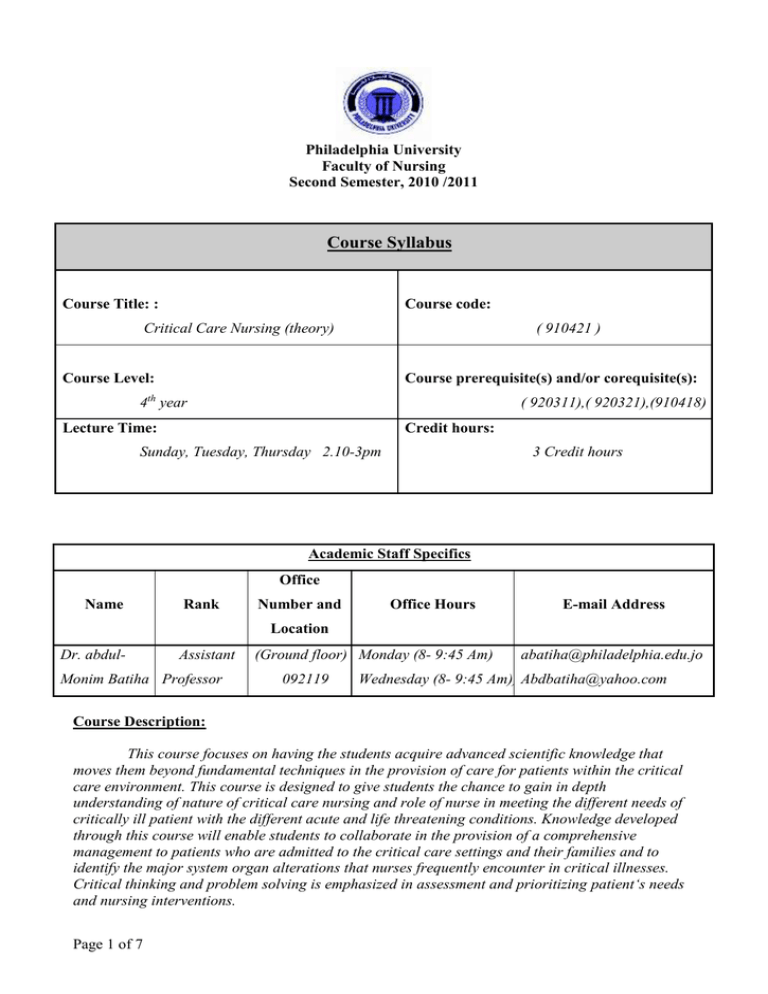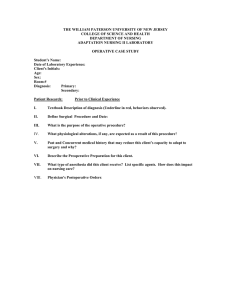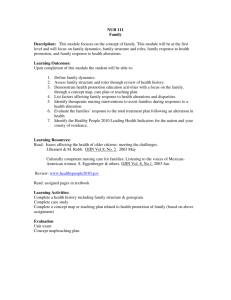Course Syllabus
advertisement

Philadelphia University Faculty of Nursing Second Semester, 2010 /2011 Course Syllabus Course Title: : Course code: Critical Care Nursing (theory) ( 910421 ) Course Level: Course prerequisite(s) and/or corequisite(s): 4th year ( 920311),( 920321),(910418) Lecture Time: Credit hours: Sunday, Tuesday, Thursday 2.10-3pm 3 Credit hours Academic Staff Specifics Office Name Rank Number and Office Hours E-mail Address Location Dr. abdul- Assistant Monim Batiha Professor (Ground floor) Monday (8- 9:45 Am) 092119 abatiha@philadelphia.edu.jo Wednesday (8- 9:45 Am)) Abdbatiha@yahoo.com Course Description: This course focuses on having the students acquire advanced scientific knowledge that moves them beyond fundamental techniques in the provision of care for patients within the critical care environment. This course is designed to give students the chance to gain in depth understanding of nature of critical care nursing and role of nurse in meeting the different needs of critically ill patient with the different acute and life threatening conditions. Knowledge developed through this course will enable students to collaborate in the provision of a comprehensive management to patients who are admitted to the critical care settings and their families and to identify the major system organ alterations that nurses frequently encounter in critical illnesses. Critical thinking and problem solving is emphasized in assessment and prioritizing patient‘s needs and nursing interventions. Page 1 of 7 Course Objectives: - Identify the major problems and needs of critically ill patient - Provide comprehensive care for critically ill patients with different acute and life threatening conditions following nursing process Course Components :- Foundations of critical care nursing - Management of acute / life threatening pulmonary alterations - Management of acute / life threatening cardiovascular alterations - Management of acute/ life threatening neurological alterations - Management of acute /life threatening endocrinal alterations - Management of acute / life threatening renal alterations - Management of acute / life threatening gastrointestinal alterations - Management of acute / life threatening multisystem alterations Textbook: Title: Critical care nursing : a holistic approach, 8 th edition, Author: Morton P , Fontaine D, Hudak C , Gallo B Publisher: Lippincott Williams & Wilkins, Philadelphia, 2005 ., In addition to the above, the students will be provided with handouts by the lecturer. Module References Students will be expected to give the same attention to these references as given to the Module textbook(s) 1. Urden L ,Stacy K ,Lough M ,Priorities in critical care nursing ,4 th edition, Mosby,Inc,USA,2004 2. Sole M, Klein D, Moseley M, Introduction to critical care nursing,4 th edition ,Elsevier Inc, USA, 2005 3. Robinson j critical care challenges: disorders, treatments , and procedures, 1 st edition, Lippincott Williams and Wilkins :a Wolters Kluwer company Philadelphia, 2003 Teaching Methods: - Interactive Lecture, discussion, , Reading Assignment, Seminar presentation Learning Outcomes: Knowledge and understanding - Identify the scope of critical care nursing - Discuss the needs / problems of patients in critical illness - Demonstrate an understanding of nursing management for patient with sleep deprivation. - Discuss the nursing management for critically ill patient with sensory perceptual alterations - Demonstrate an understanding of effect of stress on critically ill patient - Recognize the different types of delirium in critically ill patient and its nursing management - Describe the nursing interventions for the different pulmonary alterations in critically ill patient such as atelectasis, aspiration pulmonary edema, pulmonary embolism and acute respiratory failure…etc - Demonstrate an understanding of the different modes and settings of the mechanical ventilation Page 2 of 7 - Discuss the nursing management of mechanically ventilated patient - Describe the nursing interventions for patient with the different cardiovascular alterations such as angina pectoris, myocardial infarctionm, cardiac dysrhythmias….etc - Demonstrate an understanding of principles, code, modes and settings of cardiac pacing - Discuss the nursing management of patient with cardiac pacemaker - Discuss the role of nurse regarding patient undergoing cardiac catheterization & cardiac surgery - Discuss nursing management of the different neurological alterations such as peripheral neurological disorders , cerebrovascular stroke , increased intracranial pressure ….etc - Discuss nursing management of the different endocrinal alterations such as diabetic coma , adrenal crisis & insufficiency ….etc - Discuss nursing management of the different renal alterations such as acute renal failure and acute tubular necrosis - Discuss nursing management of the different gastrointestinal alterations such as upper gastrointestinal bleeding , acute pancrititis…..etc - Discuss nursing management of disseminated intravascular coagulopathies and multiple organ disfunction syndrome Cognitive skills (thinking and analysis). - Demonstrate the ability to analyze ECG tracing - Demonstrate ability to Interpret ABGs analysis results - Recognize the different types of dysrrhythmias from ECG tracing - Demonstrate ability to select the appropriate nursing diagnosis for critically ill patient with the different body systems alterations Communication skills (personal and academic). - Recognize the different methods of communications with critically ill patient - Recognize the important data to communicate verbally - Identify the proper documentation of the pertinent data Practical and subject specific skills (Transferable Skills). - Recognize the important ethicolegal issues related to critically ill patient Course Evaluation Allocation of Marks Assessment Instruments First examination 3/4/2011 Second examination 8/5/2011 Quizzes 10% Presentation of seminars 5% Professionalism, Participation, discussion & attendance 5% Final Exam 2/6/2011 Total Mark 15 points 15 points 20 points 50 points 100% * Make-up exams will be offered for valid reasons only with consent of the Dean. Make-up exams may be different from regular exams in content and format. Page 3 of 7 Course Academic Calendar Week (1) Date 20-24/2 Content Registration Introduction to the course syllabus Identify students with special circumstances (2) 27/3- 3/3 Foundation of critical care nursing Scope of Critical Care Nursing The patient’s & family experience with critical illness Impact of the critical care environment on the patient Stress, sleep, delirium. (3) 6-10/3 Management of Respiratory Alterations Mechanical ventilation Mechanical ventilation Ventilator-associated pneumonia (4) 13-17/3 (5) 20-24/3 (6) 27-31/3 (7) 3/4/2011 3-7/4 (8) 10-14/4 (9) 17-21/4 Page 4 of 7 Special Comments Acute respiratory failure Atelactasis Aspiration Acute pulmonary edema Pleural effusion Assign Coordinators & communication channels Reading assignment - Ethico-legal issues in critical care nursing - Pain in critically ill patient - Prevention of infection - Health teaching Reading assignment - Anatomy & physiology of respiratory system - Respiratory diagnostic Procedure - Pneumonia - Status asthmatics First Quiz Acute respiratory distress syndrome Pulmonary embolism Pulmonary hypertension First Exam Management of Cardiovascular Alterations Coronary atherosclerosis Myocardial infarction Angina pectoris Cardiac dysrhythmias Cardiac dysrhythmias Cardiac surgery Artificial pacemaker Shock Shock Reading assignment - Anatomy & physiology of cardiovascular system - Cardiovascular diagnostic procedure - Valvular heart disease Second Quiz . (10) 24-28/4 (11) 1/5/2011 عيد العمال Management of Neurological Alterations Acute Cerebrovascular Accident\Stroke Increased intracranial pressure & Intracranial pressure monitoring Cerebral aneurysm &subarachnoid hemorrhage 1- 5/5 (12) 8/5/2011 8-12/5 (13) 15-19/5 (14) 22-26/5 Status epileptics Encephalitis & meningitis Peripheral Neuromuscular disorders ( Guilliane barree syndrome, Myasthenia gravis) Second exam Management of Renal system Acute renal failure Fluid and electrolyte disturbances Management of Gastrointestinal system Upper and lower gastrointestinal bleeding Fulminant hepatic failure Nutritional support for critically ill patient Multiple organ dysfunction syndrome and systemic inflammatory response syndrome Seminars on management of cardiovascular alterations Acute heart failure Hypertensive crises Aortic disease (15) 29-2/6 Page 5 of 7 Reading assignment on - Anatomy & physiology of neurological system - Neurological diagnostic procedures Infection and inflammation of the heart ( Endocarditis ,Pericarditis ,Myocarditis ) Cardiomyopathies (dilated, hypertrophic, restrictive) Seminars on Management of Endocrine Alterations Diabetic coma Adrenal gland dysfunction (crisis\insufficiency) Anti-diuretic hormone dysfunction Thyroid dysfunction Seminars on Management of Gastrointestinal Alterations Acute pancrititis Peritonitis Hepatitis Seminars on Management of Multisystem Alterations Disseminated intravascular coagulopathy Reading assignment on - Anatomy & physiology of other body system - Diagnostic procedures of other body systems 2/6/2011 Systemic lupus erythematosus Final Examination Attendance Policy: - Absence from lectures and/or tutorials shall not exceed 15%. - Absence will lead to decrease in the score of professional behavior & score of discussion & participation. - In case of absence because of presence of first or second or final exam for any other subject in the same time, the student must inform the teacher in advance and submit a signed document from the teacher of other subject reveals this in the day just after absence. - Students who exceed the 15% limit without a medical or emergency excuse acceptable to and approved by the Dean of the relevant college/faculty shall not be allowed to take the final examination and shall receive a mark of zero for the course. - If the excuse is approved by the Dean, the student shall be considered to have withdrawn from the course. Documentation and Academic Honesty - Submit your home work covered with a sheet containing your name, number, course title and number, and type and number of the home work (e.g. tutorial, assignment, and project). Any completed homework must be handed in on the due date. Submission after the deadline will lead to one grade decrease in the score of the home work for each delayed day in addition to decrease in score of professional behavior. After the deadline “zero” will be awarded. You must keep a duplicate copy of your work because it may be needed while the original is being marked. Protection by Copyright 1. Course work, reports, and essays submitted for assessment must be your own work, unless in the case of group projects a joint effort is expected and is indicated. 2. Use of quotations or data from the work of others is entirely acceptable, and is often very valuable provided that the source of the quotation or data is given. Failure to provide a source or put quotation marks around material that is taken from elsewhere gives the appearance that the comments are ostensibly your own. When quoting word-for-word from the work of another person quotation marks or indenting (setting the quotation in from the margin) must be used and the source of the quoted material must be acknowledged. 3. Sources of quotations used should be listed in full in a bibliography at the end of your piece of work. Avoiding Plagiarism. 1. Unacknowledged direct copying from the work of another person, or the close paraphrasing of somebody else's work, is called plagiarism and is a serious offence, equated with cheating in examinations. This applies to copying both from other students' work and from published sources such as books, reports or journal articles. Page 6 of 7 2. Paraphrasing, when the original statement is still identifiable and has no acknowledgement, is plagiarism. A close paraphrase of another person's work must have an acknowledgement to the source. It is not acceptable for you to put together unacknowledged passages from the same or from different sources linking these together with a few words or sentences of your own and changing a few words from the original text: this is regarded as over-dependence on other sources, which is a form of plagiarism. 3. Direct quotations from an earlier piece of your own work, if not attributed, suggest that your work is original, when in fact it is not. The direct copying of one's own writings qualifies as plagiarism if the fact that the work has been or is to be presented elsewhere is not acknowledged. 4. Plagiarism is a serious offence and will always result in imposition of a penalty. In deciding upon the penalty the Department will take into account factors such as the year of study, the extent and proportion of the work that has been plagiarized, and the apparent intent of the student. The penalties that can be imposed range from a minimum of a zero mark for the work (without allowing resubmission) through caution to disciplinary measures (such as suspension or expulsion). Page 7 of 7

